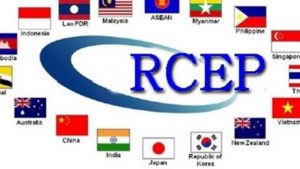Regional Comprehensive Economic Partnership (RCEP):

The RCEP will come into effect on January 1, 2022, marking the formation of the world’s largest free trade zone in terms of trade volume.
- RCEP is a trade deal between the 10-member Association of Southeast Asian Nations (ASEAN) and China, Japan, South Korea, Australia and New Zealand.
Aims and Objectives of RCEP:
- To lower tariffs, open up trade in services and promote investment to help emerging economies catch up with the rest of the world.
- To help reduce costs and time for companies by allowing them to export a product anywhere within the bloc without meeting separate requirements for each country.
- It also touches on intellectual property, but will not cover environmental protections and labour rights.
- RCEP will cover about 30% of global gross domestic product (GDP), worth $26.2 trillion (€23.17 trillion), and nearly a third of the world’s population, some 2.2 billion people.
- Under RCEP, around 90% of trade tariffs within the bloc will eventually be eliminated.
- RCEP will also set common rules around trade, intellectual property, e-commerce and competition.
India withdrew from the RCEP largely because of concerns it would open it up to Chinese goods amid an already wide trade imbalance with China, and the failure of the agreement to adequately open up to services.




